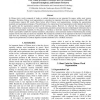Free Online Productivity Tools
i2Speak
i2Symbol
i2OCR
iTex2Img
iWeb2Print
iWeb2Shot
i2Type
iPdf2Split
iPdf2Merge
i2Bopomofo
i2Arabic
i2Style
i2Image
i2PDF
iLatex2Rtf
Sci2ools
LREC
2010
2010
Adapting Chinese Word Segmentation for Machine Translation Based on Short Units
In Chinese texts, words composed of single or multiple characters are not separated by spaces, unlike most western languages. Therefore Chinese word segmentation is considered an important first step in machine translation (MT) and its performance impacts MT results. Many factors affect Chinese word segmentations, including the segmentation standards and segmentation strategies. The performance of a corpus-based word segmentation model depends heavily on the quality and the segmentation standard of the training corpora. However, we observed that existing manually annotated Chinese corpora tend to have low segmentation granularity and provide poor morphological information due to the present segmentation standards. In this paper, we introduce a short-unit standard of Chinese word segmentation, which is particularly suitable for machine translation, and propose a semi-automatic method of transforming the existing corpora into the ones that can satisfy our standards. We evaluate the usef...
| Added | 29 Oct 2010 |
| Updated | 29 Oct 2010 |
| Type | Conference |
| Year | 2010 |
| Where | LREC |
| Authors | Yiou Wang, Kiyotaka Uchimoto, Jun'ichi Kazama, Canasai Kruengkrai, Kentaro Torisawa |
Comments (0)

